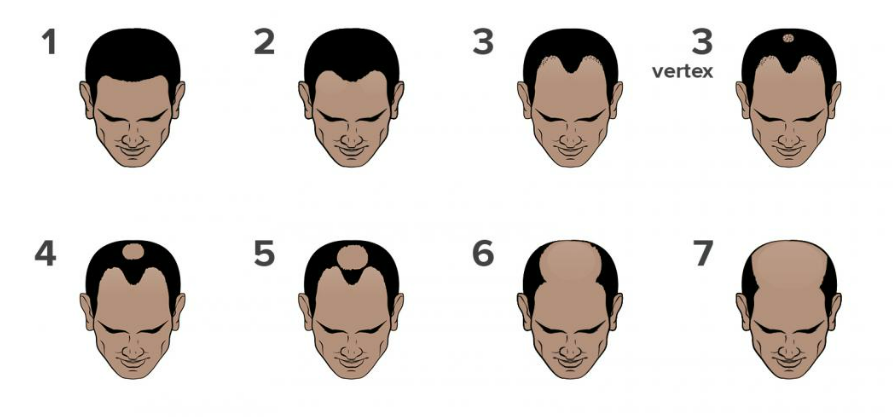1. What is the Norwood Scale?
The Norwood Scale, or the Norwood Hamilton Scale, stands as a beacon in the world of trichology and hair restoration. Introduced by Dr. O’Tar Norwood in the 1970s, it was designed to catalog the patterns and progression of male pattern baldness (MPB). Over the years, this diagnostic tool has proven invaluable not just for medical professionals, but also for those navigating the challenges of hair loss, offering a systematic way to identify the severity and potential trajectory of their condition.
The beauty of the Norwood Scale lies in its simplicity and specificity. Through pictorial representations and descriptions, it creates a roadmap for understanding the journey of hair loss for countless individuals.
2. Understanding Norwood Stages 1–7 in Detail

When you delve into the specifics of the Norwood Scale, you encounter a gradient of hair loss stages:
- Stage 1: Often mistaken for a full head of hair, this stage has minimal to no signs of hairline recession. It’s the baseline, representing no significant loss.
- Stage 2: Subtle changes begin to emerge. The temples might witness slight recessions, and while it’s an initial sign, it’s not necessarily a predictor of severe balding in the future.
- Stage 3: A defining stage. The temple recession becomes notably prominent, creating a clear M-shape. Concurrently, some individuals may begin to see the emergence of a bald patch at the crown.
- Stage 4: A more advanced phase. Here, the hairline further retreats, and the bald patch at the crown enlarges. There remains, however, a band of hair separating the two balding zones.
- Stage 5: The balding areas expand, but still maintain a degree of separation, albeit thinner than before.
- Stage 6: A significant merger occurs between the balding zones. The strip of hair that once separated the front and crown begins to diminish drastically.
- Stage 7: The final stage in the Norwood journey. Only a thin horseshoe pattern of hair remains on the sides and back of the scalp. The top is largely, if not entirely, bald.
3. Transitioning from Norwood 2 to 1: Is It Possible?
Typically, hair loss advances sequentially through stages. Yet, if factors such as lifestyle, habits, or stress instigate the thinning, making favourable changes might roll back the effects, potentially returning a stage 2 hairline to its initial state. Additionally, certain hair care products can aid in enhancing hair regrowth.
4. Unravelling the Mysteries: When Do Men Start Balding?
Hair loss, surprisingly, isn’t exclusive to the latter stages of adulthood. Genetics and hormones often conspire, triggering the onset of male pattern baldness even in late teens. Alarmingly, a significant fraction of men experience noticeable hair thinning by their mid-30s. By the age of 50, the landscape shifts drastically, with the vast majority showing clear signs of hair loss.
Data Table: Age vs. Hair Loss Percentage
| Age Group | Percentage Experiencing Hair Loss |
|---|---|
| 20-29 | 20% |
| 30-39 | 40% |
| 40-49 | 60% |
| 50-59 | 85% |
| 60+ | 90% |
5. The Ultimate Question: Will All Men Eventually Reach Norwood 7?
The progression of hair loss is as unique as our fingerprints. While many might traverse multiple Norwood stages, not all are destined for stage 7. The genetic lottery and lifestyle and health factors often dictate this trajectory.
6. Exploring the Exceptions: Why Some Men Never Go Bald
Apart from the vital genetic component, various factors explain why some men retain a full head of hair throughout their lives. Hormonal balances, optimal scalp health, adequate nutrition, absence of chronic diseases, and even reduced stress levels can contribute to hair preservation. Environmental factors, such as reduced exposure to pollutants and toxins, can also favor hair retention.
7. Hair Transplant Considerations: When is it Off the Table?
A hair transplant, often considered the last bastion against balding, isn’t a one-size-fits-all solution. Its success hinges on the availability and quality of donor hair. In instances where an individual has reached an advanced stage, like Norwood 7, with diminished donor areas, a transplant might not yield satisfactory results. It’s paramount to consult with us to evaluate this procedure’s feasibility and potential outcomes.
Understanding NW2 Hairline
The Norwood 2 (NW2) hairline is the first significant evidence of the condition in male pattern baldness, characterized by a notable recession around the temples. As will be demonstrated in the following paragraphs, this stage is essential for comprehending the evolution of hair loss:
- Characteristics of NW2 hairline: There is a slight recession around the temples.
- Formation of an M, U, or V-shaped hairline.
- Considered the beginning of a receding hairline.
- Norwood scale overview: A seven-stage classification system for male pattern baldness.
- NW2 is the first stage of actual hair loss.
- Helps in predicting future hair loss and planning treatments.
- Importance of recognizing NW2: Acts as a warning sign for potential further hair loss.
- It is not a definitive indicator of eventual baldness but a stage to monitor closely.
- The most common pattern of balding highlights the need for early intervention strategies.
It is possible to assist in the early detection and management of male pattern baldness by understanding the subtleties of the NW2 hairline and its position within the Norwood Scale. This highlights the significance of prompt consultation and prospective treatment planning.
Causes of Early Hairline Recession
It is necessary to investigate genetics, hormone cycles, and lifestyle factors to understand the myriad elements that contribute to early hairline recession. Here is a more in-depth look:
- Genetics and Hormones: Dihydrotestosterone (DHT), a derivative of testosterone, is the primary reason for male pattern baldness, also known as androgenetic alopecia. High amounts of DHT can cause hair follicles to shrink, resulting in hair loss and thinning.
- Indicating a significant hereditary component, a family history of baldness is associated with an increased probability of having similar hair loss.
- Lifestyle and Environmental Factors: Stress from both emotional and physical stress can cause the disorder known as telogen effluvium, which is characterized by sudden hair loss.
- Through the induction of stress and the modification of hair development cycles, confident lifestyle choices, such as smoking and diets heavy in saturated fats, may worsen hair thinning.
- Medical conditions, including scalp infections, diseases like alopecia areata, and treatments like chemotherapy, have been linked to hair loss.
- Age and Other Contributing Factors: The risk of hair loss escalates with age, affecting over half of males by the age of 50.
- Certain hairstyles that exert tension on the hair, known as traction alopecia, and scalp conditions like psoriasis can also lead to hair loss.
When individuals have a better grasp of these underlying causes, they can better negotiate the complexity of hair loss and choose therapies suited for their NW2 hairline.
Treatment Options for NW2 Hairline
A variety of treatment alternatives are accessible to persons who are struggling with a Norwood 2 (NW2) hairline. These treatments are suited to different demands and stages of hair loss, and each one is available to individuals. Here is a summary of the situation:
- Medications: Finasteride (Propecia): An oral medication that reduces DHT levels, slowing hair loss.
- Minoxidil (Rogaine): A topical treatment that increases hair density and stimulates new growth.
- Surgical Options: Hair Transplant Surgery (FUE): Suitable for NW2 stages involving the transfer of hair follicles to thinning areas. Requires approximately 1000-2000 grafts for optimal coverage.
- Low-Level Light Therapy (LLLT): Red and near-infrared light stimulates hair cells, promotes growth, and increases blood flow.
- Non-Surgical Treatments: Platelet-Rich Plasma (PRP) Therapy: Involves injecting the scalp with plasma to rejuvenate hair follicles.
- Scalp Massages: Regular massages can enhance blood circulation, potentially restoring hairlines within six months.
- Natural DHT Removers: A mix of Himalayan or Celtic sea salt, activated charcoal, ginger, cucumber, and lemon juice can help cleanse the scalp of DHT.
These medications, particularly when started at an early stage, have the potential to slow down the progression of hair loss considerably. They provide individuals who are suffering from the early stages of androgenetic alopecia with hope and therapeutic alternatives.
Preventive Measures and Maintenance
Eugenics Hair Sciences places a strong emphasis on the need for a personalized approach in the management of hair loss, and they advocate for early detection and intervention at the Norwood Class 2 stage. It is essential to use this preventative approach to effectively control the condition and possibly slow down the pace of hair removal. Here are some of the most crucial preventative measures and maintenance strategies:
- Regular Monitoring: The utilization of the Norwood scale for regular tracking assists in identifying any changes in the patterns of hair loss, which enables prompt interventions.
- Scalp Care: Engage in regular scalp massages to boost blood flow and stimulate hair growth.
- Choose shampoos that do not contain harsh chemicals such as parabens and sulfates to reduce the amount of hair falling out.
- Lifestyle Adjustments: Stress management techniques such as yoga can encourage new hair growth.
- Adopting a Mediterranean diet rich in antioxidants and essential nutrients supports hair health.
- Avoid tight hairstyles to prevent traction alopecia and further hairline recession.
- Treatment Options: Finasteride and Minoxidil are proven to lower DHT levels and stimulate hair growth.
- Natural oils like rosemary, peppermint, and lavender can also promote hair growth.
In addition to stopping smoking and maintaining a healthy diet, these actions contribute to establishing a solid foundation for maintaining healthy hair and preventing additional hairline recession.
Conclusion
This guide unravels the difficulties surrounding the NW2 hairline and its management through a detailed analysis. This guide also highlights the vital significance that early detection and intervention play in treating head and neck cancer. From gaining an awareness of the fundamentals of androgenetic alopecia, which include the influence of genetic and lifestyle variables, to investigating the full range of treatment and preventative methods, it is evident that addressing the initial symptoms of male pattern baldness can result in more favorable outcomes. When managing hair loss in its early phases, the importance of taking a proactive approach is shown by the emphasis placed on prompt consultation, personalized treatment programs, and lifestyle adjustments.
The road from recognizing the first signs of hair loss to taking decisive action is distinguished by the possibility of significantly slowing the progression of baldness via informed choice and action. This is how the trip begins. Individuals are provided with the resources necessary to appropriately face and manage their NW2 hairline, as they have access to various solutions that include drugs such as Finasteride and Minoxidil and surgical and non-surgical therapies. Furthermore, the pursuit of preventative measures and regular maintenance not only promotes the health of the hair but also gives individuals the ability to navigate the road of hair loss with confidence and optimism.
FAQs
What Exactly is a NW2 Hairline?
The Norwood 2 (NW2) hairline is commonly referred to as a “mature” hairline. It indicates the beginning of considerable hair loss in males as they progress through their aging process. The recession and thinning of hair around the temples are the defining characteristics of a hairline classified as NW2.
Can You Explain the Norwood Stage 2 Hairline?
A categorization system used to explain the course of male hair loss includes the Norwood Stage 2 hairline as one of its components. At this point, the hairline starts to recede in a unique M-shape, warning that noticeable hair loss has begun and is likely to become more severe.
What Are the Treatment Options for a Norwood 2 Hairline?
A hair transplant is a typically recommended treatment option for individuals who have a Norwood 2 hairline. On the other hand, this is often explored after other medications, such as Minoxidil or Finasteride, known to prevent additional hair loss, have been attempted.
At What Age Does a Norwood 2 Hairline Typically Occur?
It is not suggestive of male pattern baldness to have a Norwood Type 2 hairline between the ages of 17 and 30, as it is pretty standard. This type of hairline is considered normal for men within this age range and typically does not qualify for hair transplant operations. Celebrities such as Bradley Cooper and Leonardo DiCaprio are examples of men with this type of hairline.
The hair loss journey is deeply personal, and while scales like Norwood offer a framework, each person’s experience is unique. It’s essential to approach it with understanding, proactive care, and professional consultation.





